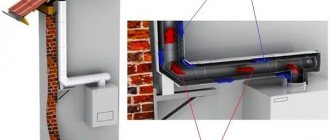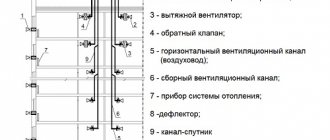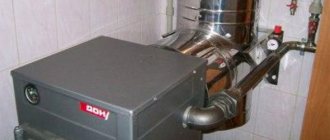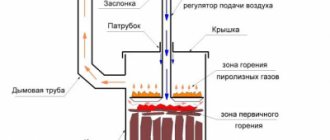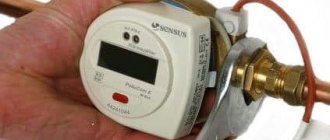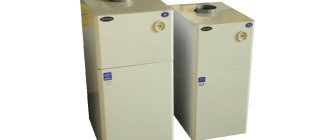Impersonal payment of utility tariffs for heating and hot water supply according to inflated standards does not suit many Muscovites. The installation of heating meters will help you avoid overpayments and pay for the actual volumes of hot water supplied, which must be ordered only from a specialized organization with a license. Before concluding an agreement, the apartment owner needs to find out the operating principle of the heat meter, clarify the advantages and disadvantages of different types of devices, the nuances of operation, taking and transmitting measurement results. According to the legislation of the Russian Federation, individual heat meters are installed on a voluntary basis. The installation is coordinated with the energy supply organization.
Tachometer heat meters
Tachometer heat meters (vane, turbine, screw) are the simplest devices.
The principle of operation of mechanical heat meters is based on the transformation of the translational motion of the fluid flow into the rotational motion of the measuring part. Mechanical heat meters consist of a heat calculator and mechanical rotary or vane water meters. These are the cheapest heat meters yet, but to their cost it is necessary to add the cost of special filters that are installed in front of each mechanical heat meter. As a result, the price of such kits is 10-15% lower than heat meters of other types, but only for nominal pipeline diameters of no more than 32 mm. For larger diameter pipelines, the price of mechanical and other heat meters is almost equal or even higher. The disadvantages of mechanical heat meters include the impossibility of using them in conditions of increased water hardness, the presence of small particles of scale, rust and scale, which clog filters and mechanical flow meters. For these reasons, throughout almost all of Russia, the installation of mechanical flow meters is permitted only in apartments, small private houses, etc. In addition, mechanical flow meters create the highest water pressure loss compared to other types of flow meters.
Electromagnetic heating meter
This is an expensive model of thermal devices, and is one of the most precise devices. The principle of operation of an electromagnetic meter is that the coolant passes through the device, while the electromagnetic field conducts a weak current. This device needs to be maintained, that is, cleaned periodically.
Rice. 4 Electromagnetic heat meters
The electromagnetic device consists of 3 main parts:
- Primary converter;
- An electronic unit that can operate both from batteries and from the mains;
- Temperature sensors.
In this case, the electromagnetic heat device can be installed in any position (horizontal, vertical, or at an angle), but this is only in the case when the area where the meter is installed is constantly filled with coolant.
If the diameter of the pipe does not match the diameter of the device flange, then adapters can be used.
Operating principle of the heat meter
01 January 2015. Written by Super User. Posted in Useful articles
Heat meters, by their nature, come with a mechanical and ultrasonic flow meter, which determines the cost of an apartment heat meter. The heat meter is installed on both the supply and return pipelines of the heating system, which is permitted by the manufacturer. How does a heat meter work, a heat meter for an apartment. The principle of operation is based on the amount of water that passes through the installed heat meter and the difference in coolant temperatures in the supply and return pipelines. As everyone knows, hot water enters the radiators (radiators) and heats the air inside the room, from which we get the difference in water temperatures at the entrance and exit from the apartment.
Q - amount of heat consumed
m—mass flow rate of coolant, [m 3 /hour]
c — heat capacity of the coolant, [Gcal/kg⋅°С]
t1, t2 are the temperatures of the coolant at the entrance to the system and at the exit from it, respectively,
The heat meter data from the water flow sensor is transferred to the computer, and it also receives data from two temperature sensors, which are respectively located in the supply and return pipelines. The computer processes the original data and stores it in the archive. All necessary information for the user is transmitted to the screen and can also be read by a data collection system via radio channel or wired Mbuss.
Generating a report:
You have installed an individual heat meter (heat meter) and the question immediately arises of how to read the information and generate a report for the heat supply organization. It is necessary to study the operating instructions for the installed heat meter, which describes how to correctly view the necessary information. Depending on the manufacturer of the heat meter, thermal energy is displayed on the display in different physical quantities. This is necessary, 1 Gcal = 4.187 GJ = 1163 kW/hour, for the correct transfer of thermal power. The operating organization often issues invoices according to the tariff in Gcal, so the transfer system must be understood.
Each resident who has purchased a heat meter needs to know that, along with the actual readings of the individual heat meter for the apartment, it is necessary to pay for heating of common areas, such as staircases, elevators, basements, on average 0.5 UAH. for 1 m2 of the apartment’s own area.
The methodology for calculating this payment is based on the following legal documents:
Resolution dated 21 June 2005 N 630 About the confirmation of the Rules for the provision of services from centralized burning, cold supply
and hot water and water supply and a standard contract for the provision of services from central heating, supply of cold and hot water and water supply.
Order 31.10.2006 N 359 About the approval of the Methodology for the recovery of the amount of heat generated by the burning of the fireplace of large apartment buildings, and the corresponding payment for their burning
Order 02/22/2008 N 47 About the confirmation of the Recommendation to sterilize the Methodology for the expansion of the amount of heat produced by the scorching of the fireplace of rich apartment buildings, and the increase in payment for their scorching.
Sheet No. D11-10/37466 dated 10/14/2002. Based on the clarifications of the Ukrainian ZNDPI on civil life, 1.2 recommendations are the coefficient for the recovery of the amount of thermal energy spent on the scorched area of the fireplace and on the unfurnished fireplace. and heat losses.
Individual heat meters
Installation of an individual heat meter is not necessary. It is installed at the request of the apartment owner, as stated in the Decree of the Government of the Russian Federation dated 05/06/11 No. 354 (clause 3, article 33, section V).
According to the Order of the Ministry of Regional Development dated December 29, 2011 No. 627, individual meters are prohibited from being installed in apartments with vertical wiring.
In addition, in order for the calculations for heating to take into account the readings of apartment meters, they must be installed in each residential and non-residential premises of the apartment building along with a general heat energy meter.
More information about the types of individual heat meters and their purpose is contained in the material “Heat meters for heating in an apartment.”
Household heating meter device features
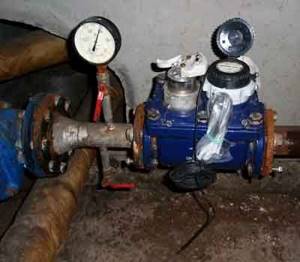
Common house heating meter.
This device is used in residential buildings. At a meeting of residents, the issue of installing a common building heating meter is decided - a common device has a number of advantages over an individual meter. Firstly, a common house meter will be much cheaper. Secondly, the readings of the device will be calculated in accordance with the number of residents, that is, you do not need to pay so much. This utility service is paid for by the responsible person, who is elected at the meeting. This person is also responsible for purchasing the meter. A common house meter costs much more than an individual type of device, but if divided equally between residents, it will be profitable.
You can install a common house meter yourself. To do this, you need to connect it to the central pipe, which provides heating to the house through the house manifold. The second installation method is reverse installation. This pipe removes waste coolant from the radiator. Both methods of connecting the device are not characterized by the complexity of the work.
The radiator, inside which the heat exchange process is regulated, is also a device for connecting the meter. To avoid problems during its installation, invite a specialist. However, you will have to pay an additional amount for the services of a master. A common house heating meter is installed in the radiator: this will make it easier for you to take readings.

Construction of a heating meter for a common building.
An individual type meter is purchased and installed in the apartment by the owner. He pays for everything: the device, the services of the master, receipts. That is, the heat meter belongs to him personally, he is fully responsible for it. A conventional device like this is an ideal solution in case of refusal of a common house meter. The presence of this device greatly simplifies your life: this way you will be calm about the honesty of payment for heating. Therefore, it is necessary to install a heat meter, even if the neighbors are against the common system.
There are some difficulties in installing an individual meter. For example, if your house has vertical wiring, then the work scheme takes place in several stages, since there is no central part of the heat supply. That is, it is necessary to introduce a riser into all rooms of the apartment.
The problem is solved by attaching a heat meter to the radiator. The radiator regulates the heat transfer process, and the attached device regulates the amount of heat produced. At the same time, the meter works efficiently and for a long time. The price of a heating meter for an apartment is much more expensive, since it is considered more reliable and has a warranty from the manufacturer.
What types of communal meters are there?
The industry produces several types of metering devices. They differ in performance and operating principles.
Mechanical
A tachometer or mechanical counter records the passage of coolant using an impeller or rotor. The rotor revolutions are counted by a computing unit.
The structure includes heat sensors and a computing unit. This is a device designed for a small home.
The mechanism is demanding on the quality of the coolant. In networks with low-quality coolant, dirty and hard water, tachometer meters are not installed. During installation, it is necessary to install a magnetic-mechanical filter.
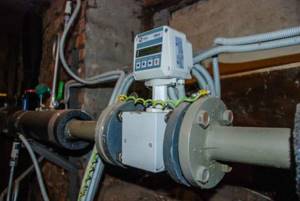
Ultrasonic
The measuring principle is based on the passage of ultrasound through a stream of water. The devices are sensitive to mechanical inclusions and air bubbles in the coolant.
If they are present in water, it is impossible to obtain reliable data. This is an expensive and reliable device. Can work for a long time with high-quality coolant.
Electromagnetic
Accounting is carried out on the basis of counting the passage of liquid processed by a magnetic field in an electromagnetic unit. Where the liquid is magnetized, and in special modules the coolant is calculated.
Installation is carried out by trained specialists. Requires constant maintenance. With proper maintenance it works for a long time without repair.
The advantages include high accuracy of readings. If metal impurities are present in the coolant, the device readings will be unstable.
Vortex
The design uses the principle of vortex counting. An obstacle is placed in the path of the coolant, which creates turbulence. Their number depends on the flow.
The structure can be installed on both horizontal and vertical sections of the system. Pressure changes affect readings.
For normal operation of the heat meter, a filter for mechanical cleaning of the coolant is installed. They are not sensitive to small metal inclusions.
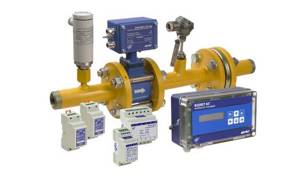
Metering devices and savings
Installing devices does not guarantee a real reduction in service fees. What needs to be done to ensure that the amounts in payments become smaller? Having installed apartment metering devices, together with control valves, you will receive and pay exactly as much as you need.
With this approach, your dependence on the actions of your housemates will be lower.
Practical installation diagram for heating meters:
- A metering device is installed at the branch point of the common riser. These works must be carried out only by professionals and sealed by specialists from the management company.
- Thermostats are installed at heating radiators. They help regulate the coolant supply. If there is no money for such a solution, then you can install a regular valve. Remember that it is not advisable to use screw versions. Because the gasket can close the pipe at an unexpected moment, which will lead to a drop in temperature in your apartment.
- Ideally, thermostats should be mechanical or electronic. The essence of their work is simple: they have a temperature sensor, which is located outside the zone of air flows ascending from the battery. After proper configuration, they will provide the system throughput that is necessary to maintain the programmed air temperature in the apartment.
What actions can be taken by owners of premises equipped with a standing heating system? Installing equipment that regulates the supply of coolant to each battery is very expensive. Such a project is unlikely to recoup the initial investment. We must not forget about the need for regular maintenance of these facilities. Installation of electronic thermometers can help owners. They are also called heat allocators. It continuously records the temperature of the air and the surface of the battery.
The cost of such a device is low (about 1000 rubles). It must be attached directly to the radiator. There will be a good incentive to save heat, since payment will be for the resource actually received.
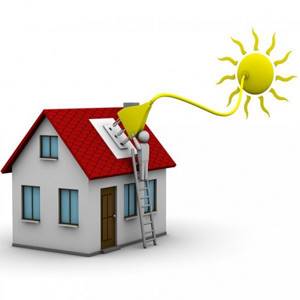
Heating system in an apartment building Heat meters for an apartment building How to change the management company in an apartment building
Replacing and installing a meter
For installation, a technical design is drawn up, taking into account the characteristics of the house. The document is approved by the service, then the device is purchased according to the recommendation in the calculation output. For installation, contact a specialized organization. You cannot install the meter yourself.
The meter is replaced in the following cases:
- the end of the operating time prescribed by the manufacturer;
- detection of mechanical or electrical damage that affects the accuracy of the data;
- violation of the control seal;
- if the check shows an excess of the possible error, the information does not correspond to reality;
- missing technical inspection time.
The fee will be calculated not according to actual consumption, but according to the average tariff, if the faulty device is not replaced in time.
Length of the straight section of the pipeline.
Many types of flow transducers require long straight runs upstream and downstream of their installation location for correct measurements. This is relevant for ultrasonic and variable pressure flow meters. But in practice, in the absence of suitable premises, it is not always possible to satisfy this requirement.
Measurement channels.
Modern heat meters are complex measuring systems that can simultaneously account for two or more heat inputs and a hot water supply line. In this case, the heat meter becomes universal and can satisfy the requirements of a wide variety of heat consumers.
Availability of a diagnostic system.
Most heat meters are equipped with a self-diagnosis system, which provides periodic automatic checks of the device’s status and provides information about the nature of the failures that have occurred, the time the failures began and their duration. At the same time, the devices can record emergency situations that arise in the heat supply system, such as the current flow rate going beyond the range set for the device or beyond the settings entered into the device memory, power failure, mass imbalance in pipelines, etc.
Energy independence.
Energy independence must be considered from two perspectives: interruptions of the network (220 V) power supply and operational safety. Power interruptions can be dealt with using uninterruptible power supplies, and safety is important when operating heat meters installed in damp and damp rooms (basements), as well as in social facilities: kindergartens, schools, etc.
Terms of Use.
When choosing heat meters, it is necessary to take into account the quality of the coolant. If there is a possibility of mechanical and gas impurities in the water, then it is not recommended to use ultrasonic and tachometer heat meters
In this case, electromagnetic and vortex heat meters are preferable. If there are ferromagnetic impurities in the water, it is not recommended to use tachometer heat meters and vortex meters with electromagnetic signal acquisition. If there are impurities in the network water that form films or deposits on the inner surface of pipelines, it is not recommended to use electromagnetic heat meters, etc.
Completeness of delivery.
When using single heat meters or composite heat meters obtained from one supplier, the compatibility of its blocks and elements and their performance as a whole are guaranteed. Otherwise, there may be problems associated with adapting the heat meter to specific application conditions and not appearing at the commissioning stage.
Intervalidation interval.
Since the verification interval is an economic category (the cost of periodic verification is up to 10% of the cost of the heat meter), heat meters with the largest verification interval should be selected. Currently it ranges from 2 to 5 years for different heat meters.
Availability and depth of the archive.
Almost all modern heat meters archive information with the ability to subsequently retrieve archived data directly from the device or using additional terminals
In this case, the ability to display archived data on the device display is important.
Cost and reliability.
The cost of a set of various heat meters varies over a wide range and depends on the thermal load of the building, the number of heat measurement channels, the need to measure pressure in the pipeline, the presence of additional external equipment (printer, modem), supplier (domestic, foreign) and other factors. The cost of a heat meter directly correlates with reliability.
Installing a heating meter
Any installation work of the heating system (including installation of a heat meter on the battery) is carried out only by specialists. To start installing a heating meter, you will need:
- Order a device installation project.
- Agree on the package containing documents for installation permission with utility companies.
- If the commission approves, then the project is implemented and heating meters are installed in the apartment.
- The meter is registered with the utility service (otherwise it is considered invalid), after which it is given for use.
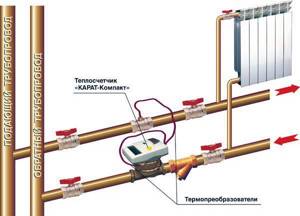
Scheme for installing meters in an apartment in a heating system.
After the above procedures, you can call specialists. They have to:
- Implement this project.
- Coordinate documentation on heat supply matters.
- Install a metering device.
- Officially register the device.
- Hand over the heat meter for use and transfer it to the supervision of the supervisory organization.
Any counter must have a passport and certificate. The documentation indicates the period for the first verification of the device by the manufacturer.
This period is also indicated on the device itself in the form of a stamp. During use of the heat meter, it is necessary to check its functionality. Meter verification is done depending on the device model. Usually it is carried out once every 4 years. After the expiration date on the stamp, you should contact either Rostest at your place of residence or an organization that specializes in meter inspections. Manufacturers should also check devices (as a rule, each company has a service center).
How to pay for heating using a meter? To pay for utilities, you should look at the number shown on the device. Next, fill out the receipt, in it you will see the difference between the current and previous readings. Finally, you multiply the number on the meter by the current tariff and pay for thermal energy.
Operating principle of the heat meter
This device has 2 sensors, one of which is called a flow sensor, the second is called a temperature sensor. The task of the first is to calculate the amount of heating consumed, the second is to measure the temperature. The main part of any meter is the heat calculator. This is a kind of calculator, it gives calculation results. To do this, the amount of heating spent on the meter is multiplied by the temperature. This way you get readings from which you then pay.
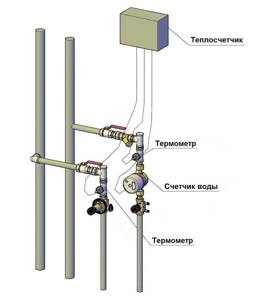
Installation of a heat meter.
Verification of meters. Verification must be performed once every 4 years. The purpose of this procedure is to determine the suitability of the device. The verifier must make a corresponding note in the device’s passport and issue you a certificate, which will confirm the functionality of the meter.
Device structure
When considering how a heating meter works, it is necessary to understand the integrated components of the device and the role they play. Standard models have three main elements:
- Flow meter.
- Temperature sensors.
- Computing node.
The first node is the main one; all subsequent calculations are based on the accuracy of its values, and if an error has crept into the flowmeter readings, then this will subsequently seriously increase the error. The device measures the amount of incoming and outgoing hot water, calculates the difference between these values and transmits the data to the computer.
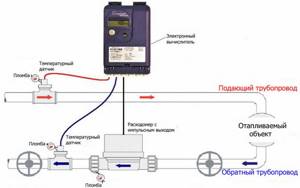
A heating temperature meter measures the heated coolant when immersed in liquid on the incoming and outgoing pipes. With its help, the computing node determines the amount of heat loss as it passes through the heating system in a specific area.
Let us describe what the heat meter consists of. This is a connection from an electronic microprocessor and a system for receiving data from other devices. It calculates the consumption of thermal energy for the reporting period, displays the data on the screen, creates, stores and transmits to the reading device various archives of the obtained values based on the settings entered by the operator upon first startup.
In addition to the main elements, the device of heat energy meters in apartment buildings includes a battery. It ensures the functioning of the electronic part of the device in the event of a disconnection of the third-party power source. Depending on the model and manufacturer, the average battery life is 10 years.
How does a heat meter work, types and characteristics of these devices
For this reason, metering the consumption of thermal energy consumed is only possible by installing a separate meter for each radiator, which is not economically feasible. In this case, it is recommended to install a group meter either on the house as a whole, or on a separate entrance (although the latter option is used very rarely).
So, where to start installing a heat energy meter:
- It is necessary to obtain a document called technical conditions from a local organization engaged in the supply of thermal energy.
The technical specifications usually indicate the location and method of installation, requirements for the meter (conditional bore diameter, temperature range and other data), in addition, an installation diagram with certain regulatory requirements for certain dimensions must be attached.Project for installing a heat meter
- Based on the technical conditions, the homeowner himself has the right to decide which meter to install for heating, but making a choice on his own is not recommended.
The fact is that the next document that needs to be obtained is a project for installing a meter for metering the received thermal energy. The development of project documentation must be carried out by a company that has the appropriate license. Be prepared for the fact that it will take a significant amount of time to develop the project, and the cost of this document is commensurate with the price of the purchased meter.
But it’s worth paying tribute to the designers, in many cases they recommend the most suitable metering device for certain conditions, so it’s worth listening to their advice.
The main thing is not to make a mistake in choosing an organization that will develop a project for installing a heat meter; try to give preference to trusted companies that have real reviews.
- The developed project is subject to mandatory agreement with the heat supply organization.
Although, serious designers resolve all these issues themselves thanks to long-established working relationships, however, this may affect the cost of project development services. - Based on the received permits, you can already select a specific meter.
Usually it is possible to purchase 2-3 modifications from different manufacturers. - Installation work should be entrusted to certified companies. Independent installation of a heat meter or the services of dubious specialists can result in problems when putting the meter into operation.
- Upon completion of all installation work, the meter must be accepted by representatives of the heat resource supplier.
On average, the entire procedure associated with installing a heat energy meter can take 1-6 months, it all depends on the amount of money invested and the efficiency of all organizations involved.
Installation of an individual heat meter
Before installing a heating meter in a separate apartment of a multi-storey building, a number of measures and actions will need to be completed, otherwise connecting the device will not be appropriate or legal.
Step one
. It is necessary to eliminate existing sources of heat loss, including cracks in windows, insufficiently insulated entrance doors, and frozen corners. Only after this the installation of a heat meter will result in significant savings.
Step two
. The management company (housing office, homeowners' association) must provide the apartment owner with technical conditions (TU) - they contain the requirements that must be met in order to connect an apartment heat meter. Typically, the text of the conditions takes up an A4 sheet. It certainly contains information about the temperature and pressure of the coolant entering the pipeline of a particular house.
Step three
. Knowing these parameters, you can start purchasing a heat meter from a company that operates legally. When purchasing a device, you must request a sales and cash receipt, a certificate confirming quality, rules and operating instructions.
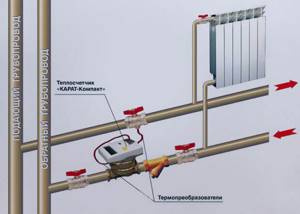
. Based on the technical specifications provided by the management company, you should order a design solution for installing a heat meter in an apartment from the design organization. The design company must have a license for this type of work.
Step five
. The thermal measuring device is installed by employees of a licensed organization specializing in this type of service.
When choosing a company, it is advisable to pay attention to a number of nuances:
- for the availability of information about the organization in the Unified State Register of Legal Entities;
- for the availability of a package of necessary documentation, including certificates, SRO approvals;
- availability of qualified specialists;
- for the availability of special equipment;
- to perform a full list of installation works;
- for the availability of a free specialist visit to the client’s apartment to inspect communications;
- for the presence of warranty obligations for the work performed.
Step six
. When the installation of the heat meter is completed, a representative of the management company (housing office, homeowners' association) must seal it and sign the acceptance certificate for the device.
To make his life easier, the apartment owner has the right to order all of the above work in one place - from a company that provides this type of service at a professional level, however, for this you will have to pay a considerable amount. If you have the desire and free time, you can prepare the installation documents yourself.
Main technical characteristics
Performance characteristics
Heat meters provide measurement, indication and registration of parameters of the coolant and thermal energy along 1...8 pipelines, their average hourly, average daily and total values, as well as operating time and the duration of emergency situations in its operation. Archive depth – 45 days.
Heat meters provide registration of the specified information on an external device (printer, PC, etc.) via the RS232, RS485, Centronics interface.
The computer is powered from a 220 V AC network.
Metrological characteristics
Heat meters, depending on their configuration with sensors, have the technical characteristics indicated in the table:
| Flow sensor type | Nominal diameter, DN, mm | Limits of flow measurement range, m3/h | Max. temperature value, °C | |
| Gname | Gnaib | |||
| VORTEX | ||||
| VRTK-2000(VPR) | 15-350 | 0.016 Gmax | 4-1600 | 150 |
| VEPS | 25-300 | 0.03 Gmax | 10-1600 | 150 |
| VEPS-TI | 20-200 | 0.04 Gmax | 4-630 | 150 |
| DRC-V | 25-100 | 0.04 Gmax | 10-200 | 150 |
| METRAN-Z00PR | 25-200 | 0.04 Gmax | 9-700 | 150 |
| UPS | 20-200 | 0.04 Gmax | 4-630 | 150 |
| DRG-M | 50-150 | 0.025 Gmax | 160-5000 | 200 |
| ELECTROMAGNETIC | ||||
| PREM | 20-150 | 0.005…0.0067 Gmax | 12-630 | 150 |
| IPRE-1(1M) | 32-200 | 0.05 Gmax | 5,6-900 | 150 |
| IPRE-3 | 32-200 | 0.04 Gmax | 22,7-900 | 150 |
| MP400 | 10-150 | 0.04 Gmax | 3,39-763 | 150 |
| IR-45 | 32-200 | 0.04 Gmax | 22,7-900 | 150 |
| "VOZLET ER" ERSV | 10-200 | 0.012 Gmax | 3,39-1357 | 150 |
| TACHOMETRIC | ||||
| PRMT | 32,50,100 | 0.1 Gmax | 1-100 | 150 |
| VST | 15,20 25-250 | 0.04 Gmax 0.05…0.08 Gmax | 3,5 7-1000 | 90 150 |
| VMG | 50-200 | 0.025 Gmax | 60-500 | 150 |
| OSVI | 25-40 | 0.02 Gmax | 7-20 | 90 |
| WPD, M-T150QN | 20-300 | 0.03… 0.09 Gmax | 3-1000 | 150 |
| M-T, WS, WP | 15-200 | 0.02… 0.05 Gmax | 1,5-600 | 120 |
| ET, WP, MT | 15-250 | 0.04…0.05 Gmax | 3-800 | 90; 120; 130; 150 |
| IMW, MT, E-T, WS, WP | 15-200 | 0.03…0.06 Gmax | 3-600 | 90; 120, 130 |
| ETW, MTW | 15-50 | 0.04…0.1 Gmax | 1,5-30 | 90 |
| ULTRASONIC | ||||
| DRC-S | 50-350 | 0.02 Gmax | 145-1000 | 150 |
| DRC-3 | 80-4000 | 0.01…0.015 Gmax | 18…450000 | 150 |
| EEM-Q | 15-50 | 0.04 Gmax | 1,5-15 | 150 |
| SONOFLO | 25-250 | 0.04 Gmax | 6-1000 | 150 |
| ULTRAFLOW II | 15-250 | 0.03 Gmax | 1,5-1000 | 150 |
| UFM001 | 50-1000 | 0.04 Gmax | 85-34000 | 150 |
| UFM003 | 15-40 | 0.02… 0.04 Gmax | 4,5-30 | 150 |
| UFM005 | 15-1600 | 0.04 Gmax | 2-36200 | 150 |
| UFM500 | >50 | 0.028 Gmax | 31,25-100000 | 150 |
| RU2K | 10-1800 | 0.04 Gmax | 2-110000 | 150 |
| SUR-97 | 25-300 | 0.01 Gmax | 20-2500 | 150 |
| URZH2K | 15-1800 | 0.04 Gmax | 0.034DN2 | 150 |
| UZR-V-M "AKUSTRON" | 50-2000 | 0.03 Gmax | 72-113400 | 150 |
| UFC002R | 50-2000 | 0.04 Gmax | 60-100000 | 150 |
| UFC-003R | 20-50 | 0.025 Gmax | 2,5-25 | 150 |
| UZS-1 | 15-2400 | 0.016 Gmax | 6,3-150000 | 150 |
| UPR-1 | 15-2400 | 0.016 Gmax | 6,3-150000 | 150 |
| URSV-010 | 50-1600 | 0.284DN | 0.028DN2 | 150 |
| URSV-010M “TAKE OFF PC” | 50-4200 | 0.0З Gnaib | 0.03 DN2 | 150 |
| URSV "VZLET MR" | 10-5000 | 0.2Du/r | 0.03 DN2 | 150 |
The calibration interval of the heat meter is 4 years.
Residential heat meter operating principle
We also recommend that you consider the benefits of a custom heat control system supplied to your home to reduce the cost of these costs. The best solutions to these savings will be found together as we look at the piping in your home.
Quarterly recording of thermal energy is possible only with a horizontal wiring system for heat supply!!! *
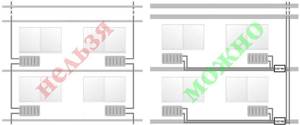
Call us or leave a request on the website, and our manager will contact you.
Our prices
| Installation cost 1 water meter | from 1700 rubles |
| Cost of replacing 1 water meter | from 1400 rubles |
| Meter installation cost | from 12,000 rubles |
| Meter replacement cost | from 7,000 rubles |
| Installing the first radiator | from 3200 rubles |
| Installing the first radiator with 2 1/2" | from 4200 rubles |
| Jumper | 1800 rubles |
| Installing the first radiator by replacing two 3/4" | from 4700 rubles |
| Jumper | 2000 rubles |
| Installing the first radiator by replacing two 1" taps | from 5000 rubles |
| Jumper | 2400 rubles |
Types of thermal heating devices
The main types of heat meters include:
- Tachometer or mechanical;
- Ultrasonic;
- Electromagnetic;
- Vortex.
There is also a classification by area of application. For example, industrial or individual.
An industrial heating heat meter is a common building (in apartment buildings) device; it is also installed at production facilities. This unit has a large diameter from 2.5 cm to 30 cm. The range of coolant amount is from 0.6 to 2.5 m3 per hour.
An individual heating device is the unit that is installed inside the apartment. It is distinguished by the fact that its channels have a small diameter, namely no more than 2 cm. And also the range of coolant amount is from 0.6 to 2.5 m3 per hour. This meter comes with 2 devices, namely a heat meter and a hot water meter.
Types of heat meters, operating principles of heat metering devices
Choosing a heat meter for heating is necessary with a full understanding of the pros and cons of individual types of device. This determines the duration of their service, the costs required for the purchase, installation and registration of the device, as well as additional amounts that may be needed to ensure the uninterrupted operation of the equipment.
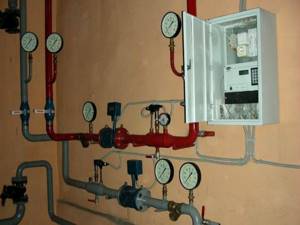
There are four types of counters:
- Mechanical or tachometer.
- Ultrasonic.
- Electromagnetic.
- Vortex.
Most often, the first two options are installed in apartments, but the others also have advantages that allow them to be considered as an alternative.
The explanation, according to the heat meter of the first type, is based on the principle of converting the translational force of the water flow into mechanical rotation of the measuring unit. Among all types of instruments, tachometer analyzers have the lowest cost. Among the advantages of mechanics, it is worth noting the simplicity of the device, which implies high reliability and durability of use. Therefore, basic investments pay off in the shortest possible time. But there are also disadvantages, the main one being the dependence on water quality. Hard, with a high content of salt and impurities, it disrupts the operation of the device. Therefore, it is necessary to install a filter before the water enters the metering area of the device, and this is an additional expense. Despite the disadvantages, mechanical counters remain one of the most popular types. Among the variety of manufacturers, consumers note the products of Kombik, Elf.
Next, let's look at how a thermal energy meter with an ultrasonic meter works. The principle of thermal energy accounting is based on reading the travel time of an ultrasonic wave from the emitter to the receiver. The signal is sent through the coolant flow and, depending on its speed, is read by the sensor after a certain period of time. Due to the fact that the recording elements do not come into direct contact with the water flow, their wear is reduced and their service life is increased.
As a heating heat meter calculates: if the mechanical meter is located in a clean pipe and the water is not contaminated with impurities, then its accuracy is maximum among all four types of devices, but lime deposits, air bubbles and other obstacles introduce significant errors in the operation of the equipment.
An additional disadvantage will be the dependence on a constant power source. In regions where there are frequent power outages, full operation of an ultrasonic meter is irrational, because an additional battery will have to be installed. Users note the high quality of products from Krohne and UltraHeat.

The third option is electromagnetic heat meters for heating in an apartment building, the operating principle of which is based on the passage of water flow through a magnetic field. To generate it, an inductor is installed in the device. The calculation of the amount of energy is based on the ability of the liquid to produce voltage in the area with electrodes installed at different ends.
Devices in this category are very sensitive to the quality of installation and the purity of the liquid that flows through the magnetic field. The presence of impurities, especially metallic ones, leads to an increase in current strength, therefore, the values obtained during measurements are not accurate, and you will have to pay for non-existent Gcal.
Despite the disadvantage, a professional installation, supplemented with filtration equipment, allows for high accuracy of metrological measurements. The equipment operates successfully in single- and dual-channel systems and can be used not only in private households, but also in industrial facilities. Proline, Optiflux and Pramer demonstrate high quality workmanship.

The operating principle of the fourth type of heat meter is based on a physical phenomenon - the formation of a turbulence in the fluid flow after passing any obstacle. The heat meter circuit includes three elements:
- Triangular prisms.
- Measuring electrode.
- Magnet.
Let's look at how a heat meter works. The first part is installed in the pipe across the water flow and forms a permanent obstacle. After this, an electrode is installed that measures the physical parameters of the vortex. The magnet is installed on the outside of the pipe and is necessary to create a magnetic field. When passing through a prism at a certain speed, the coolant forms a phenomenon called the “Karman track”. In this case, a pulsation of water flow pressure appears. Measuring it and comparing it with the stored values allows you to calculate the volume of flowing hot water.
Explaining how a heat meter for heating works is not enough; the choice should be based on the positive and negative features of vortex equipment. The advantages include immunity to impurity content and scale formation in pipes, as well as the possibility of installation on a horizontal or vertical section of the heating system. Among the disadvantages, it is worth noting the water flow speed; if it is below a certain value, the device will not correctly read the volume of flowing liquid. and Rosemount, according to user reviews, produce the best equipment in this category.



